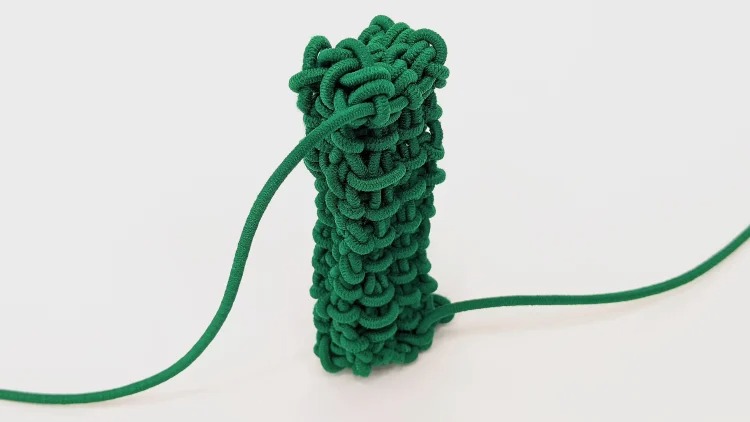- | 8:00 am
This 3D knitting machine could weave your next piece of furniture
Like a 3D printer with yarn, the prototype machine is a new approach to on-demand manufacturing.

The furniture of the future could be made from nothing more than two long strands of yarn. A prototype manufacturing machine developed at Carnegie Mellon University is transforming traditional textile fabrication into a new form of knitting that can create solid objects. Like a 3D printer with knitting needles, the machine weaves in three dimensions, forming a complex and layered clump of knits that can take the form of anything from a slipper to an ottoman. And if its developers can refine the concept further, this machine could lay the foundation for a novel form of decentralized furniture making.
The machine is designed to perform what creator Yuichi Hirose calls “solid knitting.” Hirose, a robotics Ph.D. student in Carnegie Mellon University’s School of Computer Science, explains that unlike a traditional knit, which loops back in on itself to create a flat textile, solid knitting stitches layers of knitting on top of each other, forming a dense knot that can take a wide variety of shapes.

Building a 3D knitting machine
Hirose first got the idea more than a decade ago, when he was working on a master’s degree in digital fabrication at Keio University in Japan. He was exploring the concept of reconfigurable fabrication, akin to the emerging technology of micro-robots that can bind to each other, Lego-style, and then separate. “I thought knitting also can be reconfigurable fabrication, because you can unwind it and then renew it into something else,” he says.

He finished school, got a job, but couldn’t shake the idea. So in 2018 he applied for grants, quit his job, and began building a prototype machine to automate the solid knitting process. He came to Carnegie Mellon in 2022, and is now pursuing his PhD at the university’s Robotics Institute, where he’s refined his machine to create a range of solid knit objects.
Hirose sees the machine as the first step toward a kind of reversible manufacturing tool that can use a simple material to make and remake objects like furniture automatically. “My dream would be to have solid knitting machines all over the world, and then you can just send it the data of the furniture,” he says. “So if I move back to Japan, I don’t have to bring the furniture I got in Pittsburgh. I just send the data, unwind someone else’s furniture in Japan, and then renew it into my own.”

Building a 3D knitting machine
To bring this concept into reality, Hirose is working under James McCann, an associate professor in the Robotics Institute and leader of the Carnegie Mellon Textiles Lab. McCann says Hirose’s idea is a complex but feasible alteration to commercial knitting machines that have existed for more than a century. “We’re still making the same textiles we were making 100 or 200 years ago,” he says. “The machines are the same machines, give or take some small modifications, that we were using at the beginning of industrialization.”
To knit solid objects, the Hirose’s prototype machine adds a new bit of functionality in what he calls a holder, or a kind of armature that can take a layer of knit material and position it to have another layer of knitting woven into it. “This is the core problem we need to solve in this research,” Hirose says.
Furniture is the near-term application. “I think that is an achievable challenge in the next few years and should fill a fabrication niche that we really haven’t had before,” says McCann. “We don’t have big 3E printers that can do soft objects particularly well. There’s no volumetric textile fabrication machines out there. So furniture seems like the right place to go next.”

Early experiments have shown promise. Hirose has already produced a cube-shaped ottoman and a pair of woven shoes, but says other shapes are equally possible. The three-dimensional output also means the machine is quite large. The prototype Hirose developed at Carnegie Mellon is about the size of a clothes dryer and has two somewhat menacing gears equipped with claws and hooked knitting needles. Both Hirose and McCann foresee smaller versions being possible with advanced materials like carbon fiber and metal alloys. For now, the large machine and its relatively low-resolution knitting output has been enough of a proof of concept to get Hirose working on the next generation.
Part of the challenge is making sure the machine can work with as few strands of yarn as possible. Ideally, that would be just two, which would make the unraveling of a solid knit object simpler, and the raw yarn more easily reused in another solid knit object. Luckily, the researchers only have to focus on the making side of the process and not the dismantling. “Unraveling knitting is really, really simple. You just pull on it,” says McCann. “As long as we minimize the number of yarns in an item, you don’t need a machine to unravel it. Probably a too-eager cat would suffice.”





































